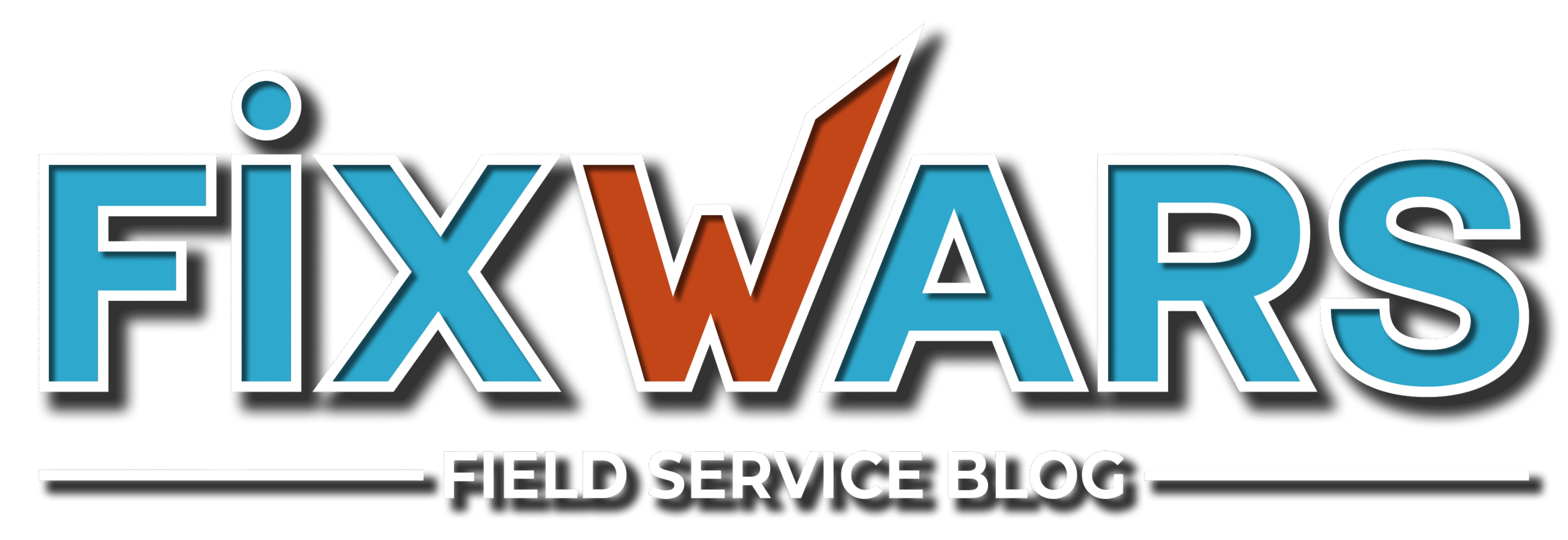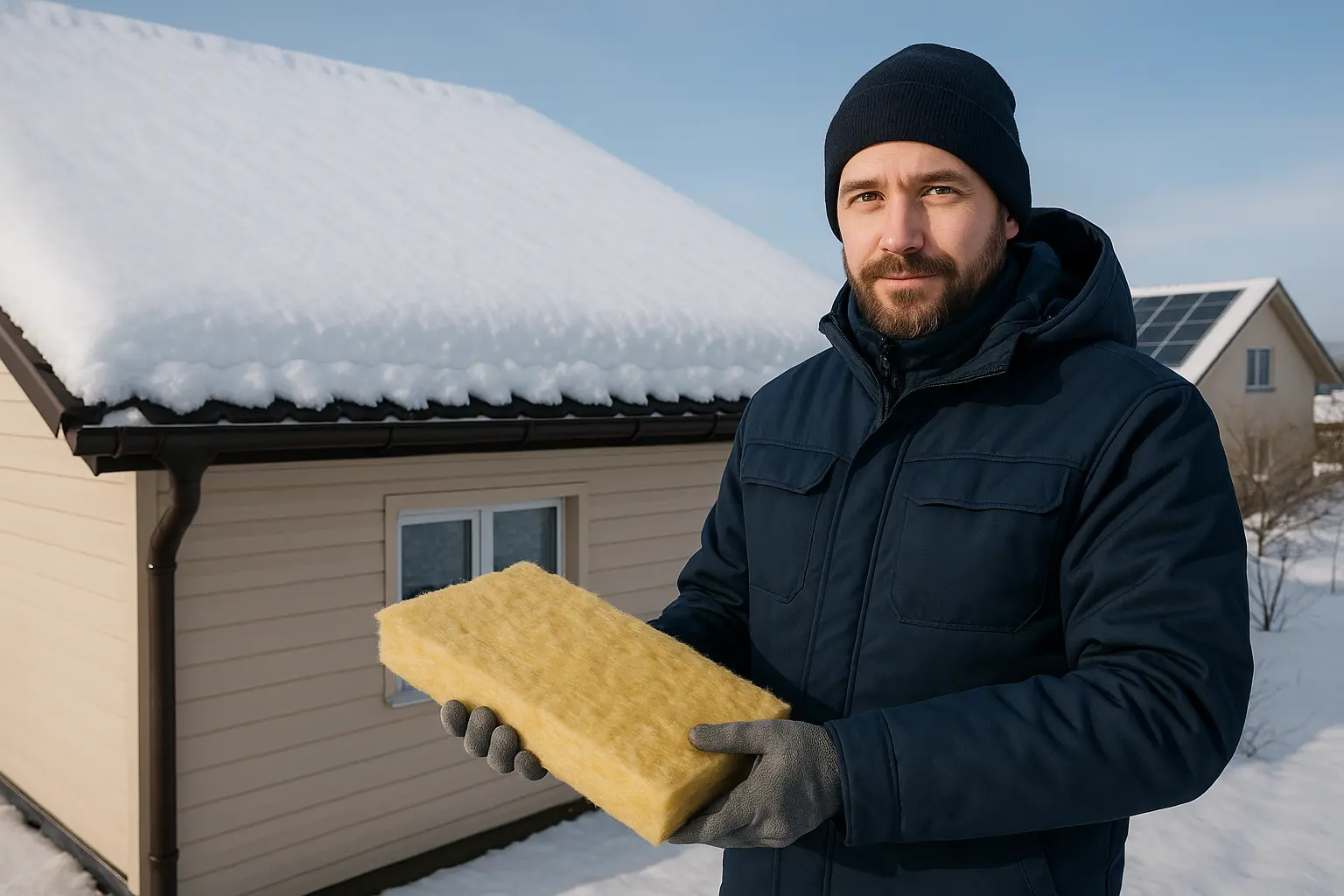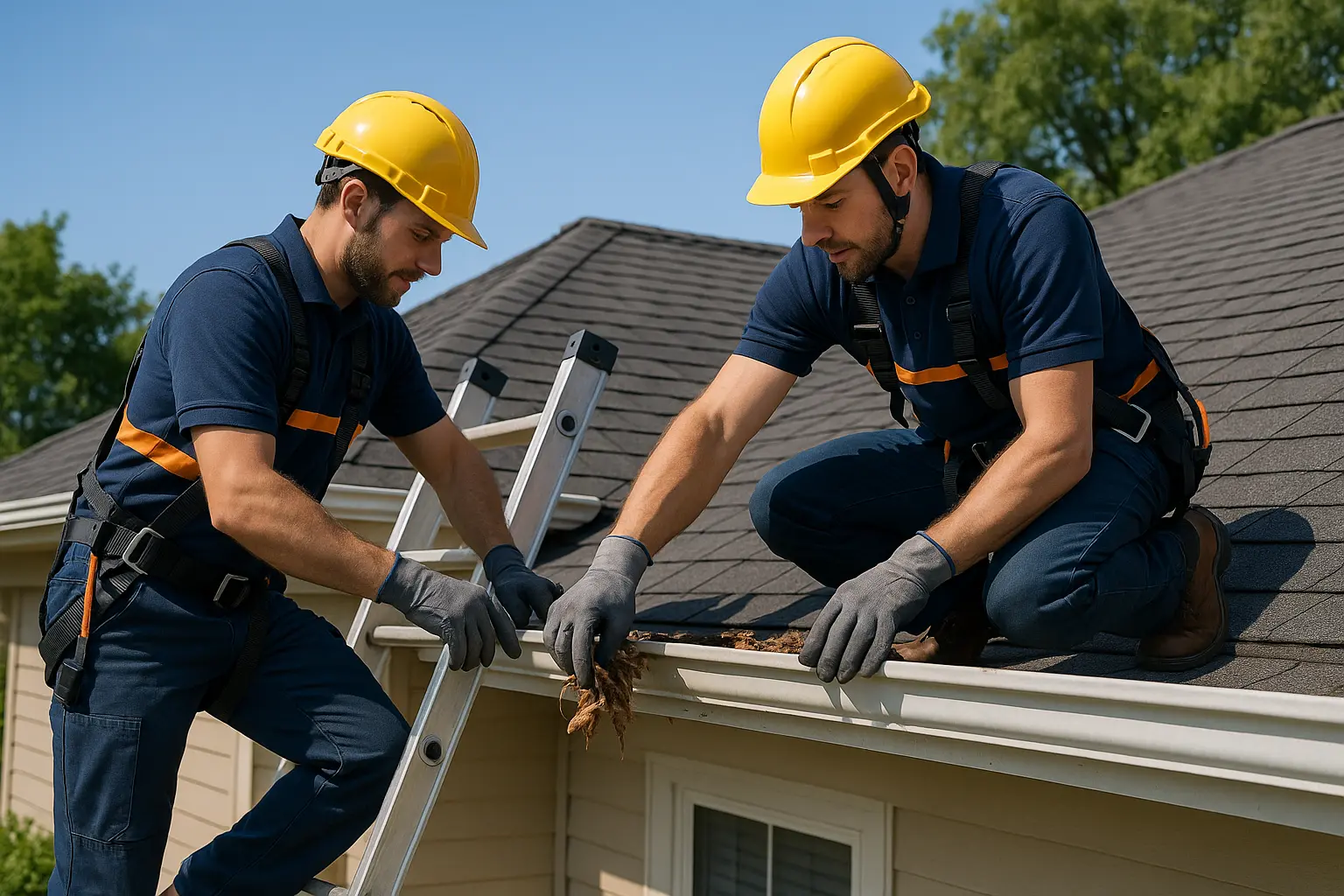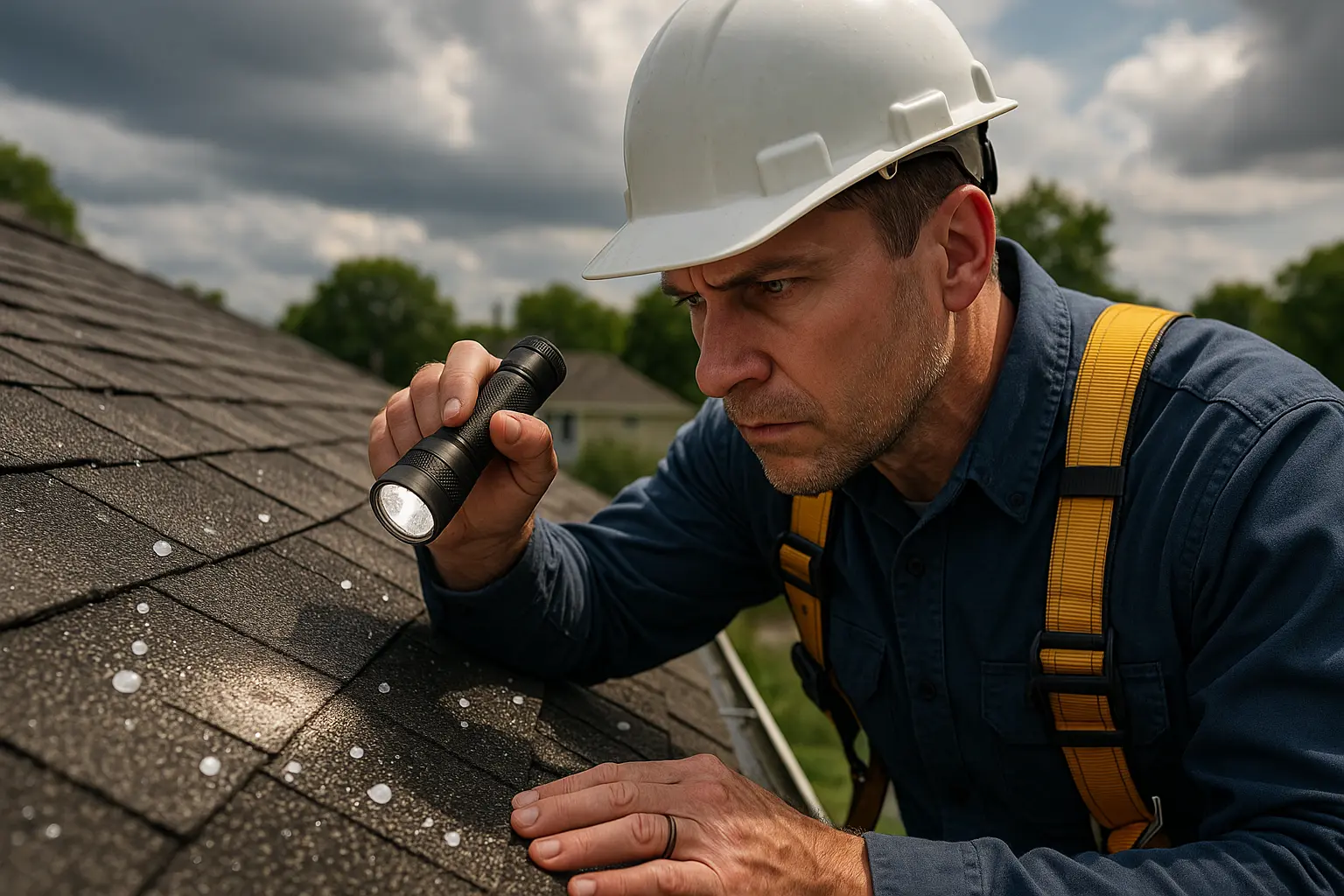Understanding Ice Damming
What Is Ice Damming?
Ice damming occurs when accumulated roof snow starts to melt during warmer parts of the day and then refreezes along the colder edges of the roof. This cycle creates a thick barrier that stops further runoff from draining away properly. Eventually, backed-up water forces its way under shingles and seeping into the layers of your home. Temperature variations during winter drive this process as sunlight warms the upper roof while eaves, lacking sufficient heat retention, remain cold enough to refreeze the meltwater.
Imagine a winter day when the midday sun softens the top layer of snow. As evening falls, the refreezing process commences along the eaves, creating a narrow band of ice. Over several days, repetitive cycles build up a substantial dam that obstructs water movement, leading to potential leaks and structural issues. This phenomenon is not only an eyesore but also a precursor to serious damage if left unchecked.
Example: On a chilly winter morning, a homeowner notices a series of icicles dangling from the overhangs. Closer inspection later reveals water stains on the ceiling and damp spots in the attic, signaling that ice damming has begun.
Why Ice Damming Matters
Ice damming is a challenge that goes far beyond aesthetics. When melted water accumulates against an ice barrier, the pressure forces it upward and beneath the roofing material, leading to leaks and interior damage. Over time, persistent water intrusion can weaken the roof deck, affect support beams, and even create conditions ripe for mold growth.
The extra weight from the ice, combined with recurring melting and freezing cycles, can shift shingles out of place. A compromised shingle system reduces your roof’s ability to shield your home, possibly exposing you to expensive repairs down the road. In cold, unpredictable climates, preventing ice damming is essential to safeguarding the integrity of your property.
Case Study: In a region known for harsh winters, one homeowner experienced severe interior water damage after an unexpected ice dam formed. Despite a relatively new roof, the intrusion led to extensive repair work affecting insulation, ceiling finishes, and even electrical fittings.
Spotting Early Warning Signs
Noticing the early signs of ice damming can save you from expensive repairs. Long icicles dangling from roof edges are often the first visual cue that water is escaping as it freezes upon contact with the cold eaves. Additionally, subtle water discolorations on interior walls or ceilings near roof overhangs can indicate that moisture is making its way inside.
Sometimes, the clues are less obvious: you might hear a persistent dripping sound on a quiet winter night or see patches of melted ice along the roof line. Even a minimal buildup can eventually transform into a significant problem if not addressed promptly.
Tip: Schedule regular winter inspections of your roof and attic. If you can’t safely access the roof, check for moisture traces in the attic or near ceiling corners to catch any issues early. Early action plays a crucial role in effective ice dam prevention.
insulation, ventilation, heat cables
insulation, ventilation, heat cables
In dealing with ice dam challenges, a balanced approach involving proper insulation, ventilation, and heat cables can be a true lifesaver. Throughout this article, you will see that this focus strategy—insulation, ventilation, heat cables—offers a reliable defense against the adverse effects of winter weather. Homeowners who refine these elements on their roofs are well on their way to enhanced protection and reduced repair costs.
By integrating robust insulation, ensuring adequate ventilation, and, when needed, installing heat cables, you create an environment that minimizes temperature differences across your roof. This condition is ideal for keeping the roof uniformly cool, which in turn significantly drops the risk of unwanted ice formation. The combination not only boosts the roof’s defenses but also promotes energy efficiency, saving you money over time.
When discussing solutions with roofing experts, you might hear them emphasize the benefits of tweaking insulation, ventilation, and heat cables together. This trio works in harmony to reduce ice dam damage and improve overall safety during winter months. The focus keyword, insulation, ventilation, heat cables, appears consistently in maintenance guides because of its proven effectiveness.
In many cases, the right balance of insulation, ventilation, heat cables, and additional ice dam prevention techniques ensures your roof stays in optimal condition all winter long. This unified strategy is key to not only safeguarding the property but also maintaining comfort inside your home.
Prevent Ice Damming Naturally
Enhance Your Attic’s Insulation
A well-insulated attic acts as a thermal barrier that prevents warm air from seeping up from living areas and heating the underside of your roof. Without proper insulation, the roof’s temperature can become uneven, kickstarting the melt-freeze cycle that builds ice dams. Modern options like spray foam or fiberglass boards keep the attic uniformly cold so that the roof stays near the ambient outdoor temperature.
Improving insulation in your attic not only bolsters ice dam prevention but also helps reduce heating costs. Many homeowners see benefits in both energy savings and reduced maintenance problems when they update their insulation systems. Enhanced attic insulation is a cornerstone in the overall approach of insulation, ventilation, heat cables, proving its importance in many maintenance tips.
Comparison: Homes that upgrade their attic insulation typically experience fewer ice dam issues compared to those that rely on older, insufficient materials. A small investment in insulation can prevent the high costs associated with water damage and subsequent repairs.
Seal Up Air Leaks
Even tiny gaps around vent pipes, chimneys, or electrical conduits can let warm air into your attic, triggering unwanted melting on the roof. Sealing these air leaks is a simple yet effective way to help maintain a consistent temperature under the roofing surface. When warm air is kept tightly within the home’s living spaces, it minimizes uneven heating on the roof itself.
Using proper sealants and weatherstripping can dramatically lower the flow of warm air into the attic. This straightforward measure complements the overall insulation, ventilation, heat cables approach. A reduction in warm air seepage equals less chance for ice dam formation during cold spells.
Example: Many homeowners have seen notable improvements after sealing air leaks. With a well-sealed attic, instances of ice dam formation have dropped even in regions with extreme winter weather, solidifying the role of an integrated strategy that includes insulation, ventilation, heat cables.
Guarantee Adequate Roof Ventilation
A properly ventilated attic helps regulate roof temperature by ensuring cool air circulates efficiently. Vents like soffit, ridge, and gable work together to expel rising warm air while drawing in cooler air from below. Maintaining clear and unobstructed vents is essential for effective temperature control overhead.
Good ventilation plays a key role in supporting the concept behind insulation, ventilation, heat cables. Without sufficient airflow, even the best insulation might falter, allowing pockets of heat that can lead to ice dam formation. When ventilation is optimized, your roof’s temperature remains consistent, and potential weak spots are minimized.
Insight: Homeowners who invest in proper ventilation often notice a significant reduction in ice dam incidents. Combining effective insulation, vigilant ventilation, and targeted heat cables creates a safe, consistent environment that actively supports ice dam prevention.
Professional Solutions and Expert Advice
Installing Roof Heating Cables
When simple repairs and preventive measures are not enough, installing roof heating cables is a viable professional solution. These electric cables are strategically placed along vulnerable roof edges to allow for the gentle melting of snow before it can freeze into a dam. Properly set up heating cables ensure that melted snow has a clear path to drain, minimizing the risk of water backing up and damaging the roof.
Roof heating cables work best in regions where ice dam issues persist year after year. Their installation should be performed by trained professionals, who tailor the setup to suit your home’s roof design and local weather conditions. Remember, many roofing specialists integrate the concept of insulation, ventilation, heat cables into their recommendations so that all aspects work together seamlessly.
Data Point: In colder areas, studies have shown that heating cables can reduce ice dam formation by up to 70%. While installation has an upfront cost, avoiding long-term water damage makes it a smart investment in your home’s longevity and overall ice dam prevention.
Consulting Roofing Experts
Sometimes, the best course of action is to call in professionals. Experienced roofing contractors can diagnose and fix areas where your insulation, ventilation, heat cables strategy might be falling short. Such experts review your current system, including roof structure, insulation integrity, and ventilation setup, to pinpoint hidden issues that could lead to ice dam problems.
Based on a thorough assessment, these professionals might suggest adding a waterproof membrane or enhancing your attic’s insulation and airflow. Their personalized advice ensures that any modifications seamlessly integrate with the overall plan for ice dam prevention. It’s always wise to check references and review past projects before settling on a contractor.
Tip: Always verify a contractor’s credentials. An expert who understands the nuances of insulation, ventilation, heat cables as part of a complete storm-proofing solution offers the best long-term benefits for your home.
Attic Assessments for Hidden Vulnerabilities
Professional attic assessments help uncover areas with insufficient insulation or poor ventilation. When experts use tools like thermal imaging, they can detect minor temperature differences that might not be apparent to the naked eye. These assessments are valuable in building an effective plan to combat potential ice dam formation.
An accurate evaluation of insulation levels, air leaks, and ventilation blockages leads to a targeted strategy for repairs and upgrades. Enhancing these elements not only improves home comfort but also actively supports ice dam prevention measures. Homeowners who address these issues experience fewer problems and enjoy a safer winter season.
Case Study: In one assessment, a homeowner discovered several gaps around electrical conduits and a poorly insulated spot near the roof peak. Correcting these shortcomings proved to be the key step in preventing recurring ice dams over subsequent winters.
Maintaining Your Roof for Winter Resilience
Timely Snow Removal
Regular maintenance during winter is crucial in avoiding the problems that ice dams can cause. After heavy snowfall, promptly removing excess snow with a roof rake helps prevent the build-up of a thick snow layer, which can lead to rapid melting and freezing cycles. Using the right tools minimizes the risk of roof damage by keeping the weight load in check.
Frequent snow removal is a proactive step in ice dam prevention. Not only does it reduce the risk of water leakage, but regular clearing also lessens the burden on your roof’s structure. Whether you choose to handle the task yourself or hire a professional, timely removal is a key element in safeguarding your home.
Best Practice: Clear off snow after substantial falls or storms. If climbing onto the roof seems unsafe, invest in a reliable service specializing in winter roof cleanup. This simple step works well with other strategies like insulation, ventilation, heat cables to maintain your roof’s integrity.
Monitoring Roof Conditions
Keeping an eye on your roof during winter can avert major headaches later. Regular inspections, whether from the ground or with the help of a professional, allow you to detect early indicators of ice dam formation such as unusual icicles or damp patches on ceilings. This vigilance is key for quick fixes that can prevent costly damage.
Homeowners can further enhance their safety by installing moisture sensors in the attic. These devices serve as an early warning system by alerting you to any unexpected humidity spikes or leaks that might contribute to ice dam problems. Combining manual checks with these tools forms an effective shield against potential roof damage.
Recommendation: Complement routine inspections with modern monitoring tools. The consistent use of insulation, ventilation, heat cables as part of your home improvement strategy ensures that problems are caught early and managed before they spiral out of control.
Pre-Winter Planning and Repairs
Preparation is essential to avoid disruption when winter hits. A thorough inspection of your roof, attic, and surrounding elements before the heavy snowfall season helps reveal vulnerabilities. Addressing these issues during warmer periods is both safer and usually more cost-effective. By planning ahead, you can improve overall home safety and significantly boost your ice dam prevention efforts.
Scheduling professional checks and routine maintenance as part of your yearly home care routine is a smart move. Upgrading insulation, sealing air leaks, and reinforcing ventilation can all be done during the fall months to set the stage for a trouble-free winter. Combining these upgrades with the strategic use of insulation, ventilation, heat cables creates a holistic defense that is hard to beat.
Insight: A prepared home experiences fewer emergencies during winter. Regular planning and timely repairs extend the life of your roof and reduce the risk of damage caused by ice damming, keeping your family safe and your home cozy.
Conclusion
To sum up, understanding the causes and effects of ice damming is key for every homeowner facing winter’s challenges. The formation of ice dams is a complex process where melting and refreezing combine to create a damaging barrier. Recognizing early signs like icicles, water stains, and subtle sounds can prevent small issues from evolving into significant structural problems.
Effective ice dam prevention begins with enhancing attic insulation, sealing off unwanted air leaks, and ensuring your roof is well ventilated. These steps help maintain an even roof temperature and work hand in hand with our focus strategy—insulation, ventilation, heat cables—to provide lasting protection. Whether tackling minor repairs or seeking professional intervention such as roof heating cable installation, every step enhances your home’s safety during winter.
Professional assessments and proactive maintenance, including regular snow removal and condition monitoring, further shield your home from the harsh impacts of ice damming. By planning ahead and investing in reliable solutions, you can sidestep the costly repairs that often follow unchecked ice dam formation.
Final Thought: Protecting your home is not a one-time task but an ongoing commitment. By staying attuned to signs of damage, employing a measured approach with insulation, ventilation, heat cables, and integrating expert advice, you set up a robust defense against ice dam challenges. In the end, a vigilant homeowner reaps the benefits of a secure, energy-efficient, and damage-free winter season—making that small investment in prevention a smart move in the long run.





